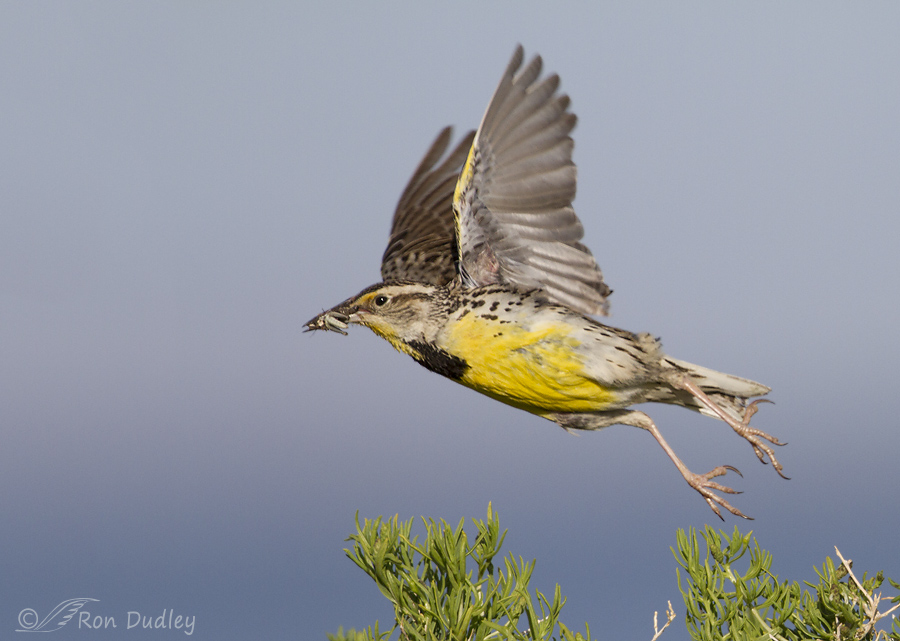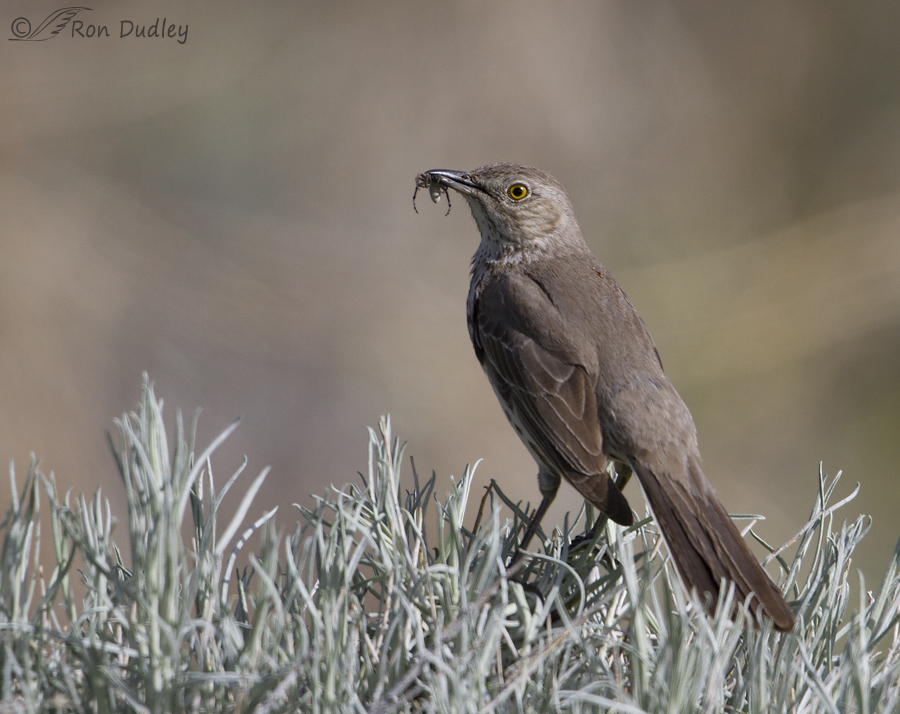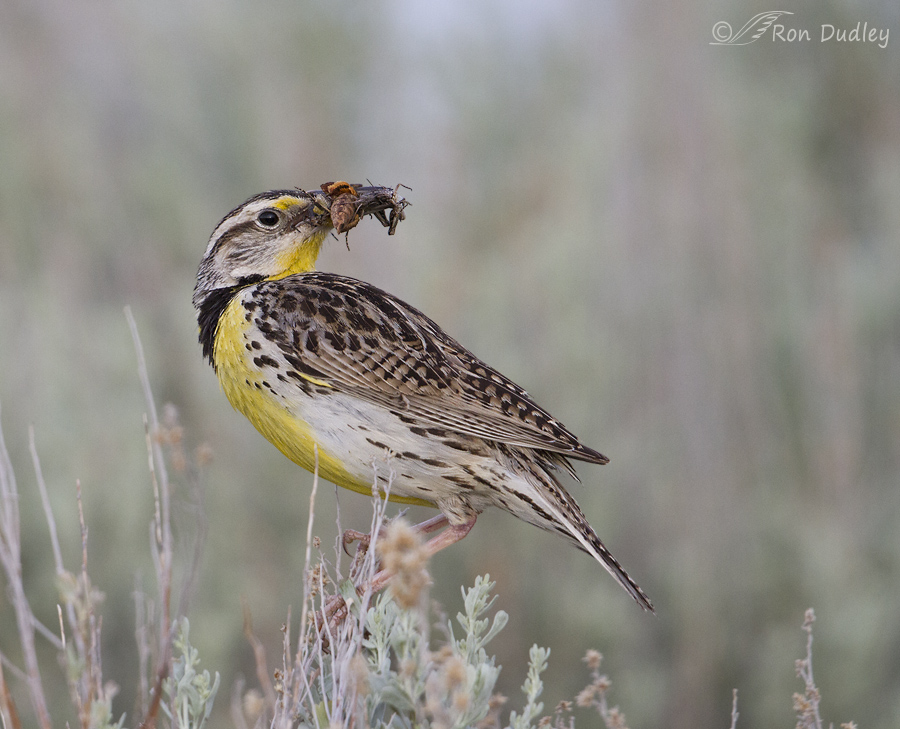Antelope Island is crawling (and flying) with “bugs” right now. Mosquitoes are common, flying midges are thick as are the dreaded biting gnats (I call this the “itching and bitching” season) and it won’t be long until the brine flies are at their peak. Grasshoppers are becoming big enough to be noticed and the famous (infamous) spiders on the island are becoming more apparent. But the timing couldn’t be better for birds, many of whom are feeding nests full of young.

1/3200, f/6.3, ISO 500, Canon 7D, Canon EF500mm f/4L IS II USM +1.4 tc, not baited, set up or called in
For most of the year it’s unusual to find a perched Western Meadowlark with insects in its beak because they usually consume them immediately after capture but when they’re feeding young they typically land on an elevated perch for a few moments before delivering the meal to the nest. This isn’t a great image but it’s a flight shot with prey so I kept it.

1/3200, f/6.3, ISO 500, Canon 7D, Canon EF500mm f/4L IS II USM +1.4 tc, not baited, set up or called in
The first Sage Thrasher fledglings are just beginning to appear but many of them are still in the nest and must be fed. This adult has a juicy spider, presumably for its nestlings.

1/1000, f/5.6, ISO 1000, Canon 7D, Canon EF500mm f/4L IS II USM +1.4 tc, not baited, set up or called in
Not many birds can cram more insects in their beaks before delivering them to the nest than meadowlarks. And their instinct to sing is so strong that they usually attempt to do so with a mouthful which is quite comical to watch (and listen to).
These first two images were taken yesterday but this meadowlark shot was taken three days ago on a morning that turned cloudy just before we got to the island. I can’t resist relating my extremely frustrating experience with light that morning. Typically I’ll cruise the island for quite a while before I get an opportunity with a bird but on this morning there was action all around me for a time. There was a Burrowing Owl perched nicely on a sagebrush, this meadowlark with a beak full of bugs (it stayed perched for a long time) and a Northern Mockingbird doing his courtship display in a performance that lasted over half an hour. In 31 minutes I fired off 680 shots of all three species but mostly of the mockingbird. I knew the action shots were likely to be marginal because of the poor light but I hoped to get lucky on a few of them. Didn’t happen. Almost all of those shots were garbage and the few I kept were marginal.
Why oh why can’t there be light when something like that happens???
Ron


“Itchin” and bitchin””-I like that. Although without the bugs, they would be no birds. I went to Big Lake and when I got there, my camera bag was empty-I had left my camera beside the computer the night before when I had downloaded.Like these shots, shows behaviour.The singing would have been funny.
I know you have very high standards for what shots you keep, but I’ll bet that most of us would like to see the behaviors even if the shots aren’t perfect. Knowing myself, and reading what your other followers say, I feel confident that we would all be interested in learning about behaviors that we might not otherwise get to see. I think a balance between beauty and behaviors (within reason) is a good way to go, because you are not always going to have good light for what you want to portray. 🙂
Sensational shots Ron, thanks for sharing!
Charlotte
Low light. That’s why I still carry big binoculars, rather than the more compact models, for birding only sojourns. Low light is a real challenge to us visual beasties.
When I want to see both butterflies and birds, I have to compromise or carry 2 pairs around my neck (too heavy for a 65 yr. old, small woman). Usually, I go with the high needed light, close focus, light weight binoculars in the summer, which requires a skill adaptation when trying to focus on birds.
I am amazed about how many insects the meadowlark can carry in its beak! I had no idea that insect providing parents might cram their beaks from front to end before returning to the nest. It make me wonder about insect providing parents, like turkeys.
Some day, Patty and I will sneak in and get access to your trash. And have a complete ball – oohing and ahhing. And saying things like ‘Can you believe how self critical that man is?’ ‘No, neither can I.’
So the meadow larks aren’t given the don’t sing with your mouth full speil? I would love to see and hear that.
Thanks Ron. Education and delight. Again.
Elephant’s Child, please invite me to go along with you and Patty for that raid. I’m certain I would react the same way as you two would. 🙂
Susan, done deal.
Sounds like a party to me!
How I would love to have your “trash”,,,,
I guess I’d make a terrible photographer…I can’t see anything wrong with these images…in fact, I think they’re great……What am I missing?
Patty, only 1 (the last one) of these three images was taken on the day with bad light and that image isn’t too bad. I was taking about the 600 images that I trashed.
The pictures are great. Just exhausting to go through that many to keep just a few. We all do it. The skies have been cloudy here for weeks. Every time I try to shoot, everything is just so dark but not depressing thanks to all my birds.
Culling images is a pain in the patoot, isn’t it, Ellen?
It looks like a paradise for birds. But even in Paradise not everything is perfect for humans.
I understand how you felt. Try to photograph on a day when the clouds run so fast and are so many but not enough to cover the entire sky only leaving you some spots of blue in between. Total madness.
I wish I could hear that Meadowlark sing with its beak full of insects. What a laugh…
Thanks for sharing.
Jorge, I call the days like you describe “light chasing days” – you chase the light and hope there’s a cooperative bird there when (if) you find it. I don’t truly giggle often but I do when one of these birds is trying to sing with its beak crammed full of insects. It’s truly hilarious.